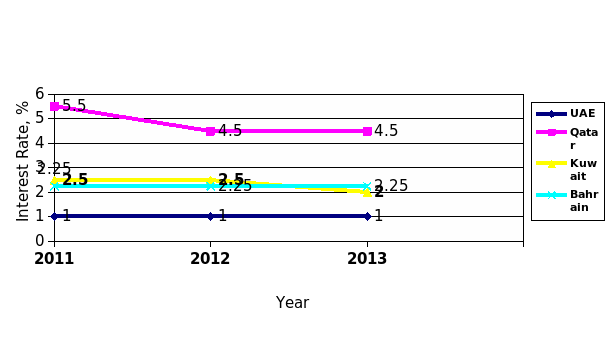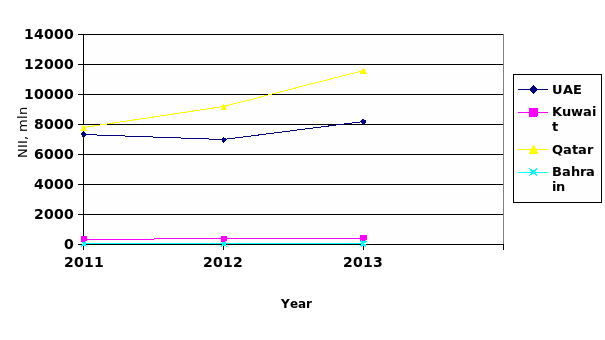Introduction
In the Gulf Cooperation Council (GCC) and MENA countries, changes in interest rates significantly influence changes in the net interest income (NII) and net interest margin (NIM). However, there are also factors that affect changes in the banks’ interest rates, depending on the size of the bank.
Changes in the Interest Rates for 2011-2013
The main factor that influences the interest rates in the MENA region is inflation. The other factors that can affect the changes in the interest rates in the GCC countries are changes in the oil prices, the state funds rates, and rates in foreign investments (International Monetary Fund, 2013, p. 14-17). Still, changes in the inflation rate are the most influential factor. In this case, such types of inflation as the domestic inflation and inflation associated with trading partners both matter because these factors influence the value of the US dollar and the states’ currency chosen for the exchange operations (Inflation in the GCC Countries, 2013, p. 2). Furthermore, it is also important to pay attention to such economic factors influencing the growth of inflation rates as the stability of the housing market, situation in the labor market, and changes in the oil prices (Ravichandran & Alkhathlan, 2010, p. 4).
In the UAE, the interest rate during the period of 2011-2013 was stable (1%) because the rate of inflation was rather low (about 1.5%). The similar situation is observed in Bahrain, where the interest rate was also stable (2.25%) because the inflation rate was not higher than 1% in the country during the period of 2011-2013. In Qatar and Kuwait, the situation was different. The high rate of inflation in Qatar (more than 4%) during the period of 2011 made banks choose high interest rates in 2011 (5.5%). The situation changed in 2012, the inflation rates decreased to about 4%, the oil prices increased, and the interest rates were lowered to 4.5% during 2012-2013 (Inflation in the GCC Countries, 2013, p. 4). In Kuwait, the high inflation rate in 2011-2012 made banks focus on the interest rate in 2.5%, and it was decreased to 2% in 2013 because the inflation became stable (about 3%) (International Monetary Fund, 2013, p. 6). From this point, changes in the inflation rate are directly connected with the changes in the interest rate. If the inflation rate is high, banks choose to compensate while setting the high interest rates (Figure 1).

Impact of Interest Rates on Net Interest and NIM in Big Banks
The analysis and comparison of such four big banks in the UAE, Qatar, Kuwait, and Bahrain as the Emirates NBD PJSC, the Qatar National Bank, the National Bank of Kuwait S.A.K., and the Ahli United Bank BSC is necessary to discuss the idea that there is the correlation between the interest rates and changes in the NII and NIM in the GCC countries. It is important to state that the net interest income in the Emirates NBD PJSC increased during the period of 2011-2013 proportionally, referring to the stability of the interest rate. As a result, during the 2011-2012, the Emirates NBD PJSC had the lowest rates of NIM (2.93%, 2.8%), and the situation changed in 2013, when the NIM raised to 3.06%.
Discussing the Qatar National Bank, it is possible to determine the correlation between the decrease in the interest rate in 2012-2013 and the significant increase in the net interest income. However, the changes in the NIM are not directly related to the changes in the interest rate. The interest rates influence the NII and NIM in the National Bank of Kuwait S.A.K., thus, the high interest rate in 2012 is associated with the lowest NIM (3.12%) and with the average NII, while comparing the NII for 2011-2013. In Bahrain, the Ahli United Bank BSC had the stable interest rate during 2011-2013, but the NII and NIM changed annually, demonstrating the increase in rates. From this point, the lowest NIM and the highest NII were characterized for the UAE and Qatar in spite of difference in the interest rates (Figure 2).

Impact of Interest Rates on Net Interest and NIM in Small Banks
Having compared such small banks as the Tamweel PJSC of the UAE, Industrial Bank of Kuwait K.S.C., the TAIB Bank B.S.C of Bahrain, and the Ahli Bank QSC Qatar, it is possible to state that the Ahli Bank QSC Qatar was the most successful bank during the period of 2011-2013 because of the rather stable interest rates, the highest NIM and NII. If the Ahli Bank QSC Qatar demonstrated the highest level of NIM, the TAIB Bank B.S.C of Bahrain demonstrated the negative rates regarding NIM, and the lowest NII. The rates of the Tamweel PJSC and the Industrial Bank of Kuwait K.S.C. were rather low, but stable during the period of 2011-2013 (Figure 3).

Conclusion
Having analyzed the impact of interest rates on the net interest income and net interest margin in such countries as the UAE, Qatar, Kuwait, and Bahrain during the period of 2011-2013, it is possible to note that the stable interest rate demonstrates stability of the inflation rates in the country. The stable interest rate is associated with the highest NII and dependent NIM. Furthermore, the stability of the interest rate during the discussed period is more influential than actual high or low interest rates.
References
Inflation in the GCC Countries: Old challenge in a new context. (2013). Web.
International Monetary Fund. (2013). Gulf Cooperation Council: Annual meeting of Ministers of Finance and Central Bank Governors. Web.
Ravichandran, K., & Alkhathlan, K. A. (2010). Impact of oil prices on GCC stock market. Research in Applied Economics, 2(1), 1-12.
